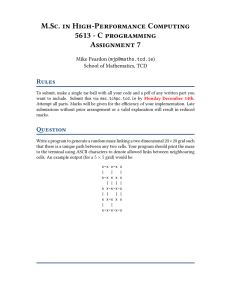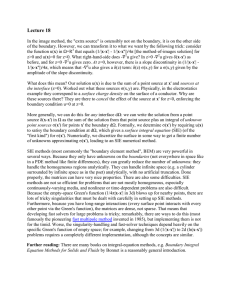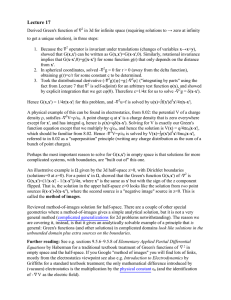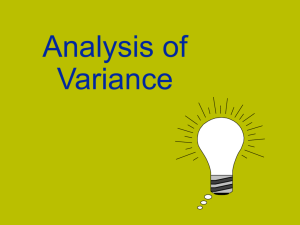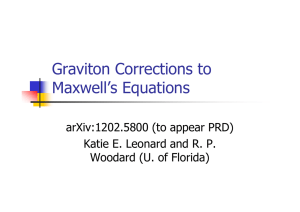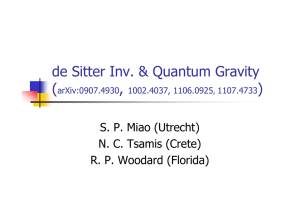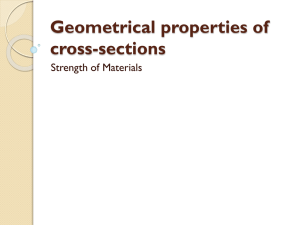Free Gravitons Break de Sitter Invariance ( , )
advertisement
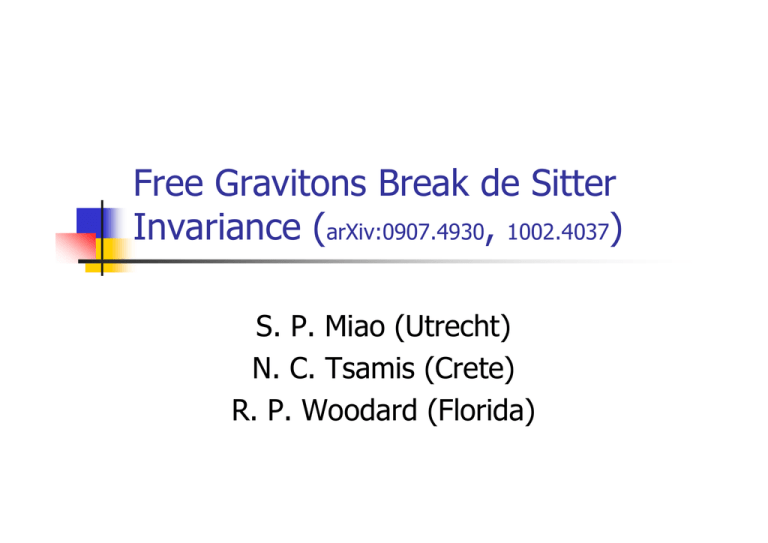
Free Gravitons Break de Sitter
Invariance (arXiv:0907.4930, 1002.4037)
S. P. Miao (Utrecht)
N. C. Tsamis (Crete)
R. P. Woodard (Florida)
Spacetime Exp. Strengthens QFT
Why?
Maximum Effect for
Loops classical physics of virtuals
Expansion holds virtuals apart longer
Inflation
M=0
No conformal invariance (classically)
Two Particles
MMC scalars
gravitons
Primordial Inflation was nearly
²
de Sitter with small GH
ds2 = -dt2 + a²(t) dx.dx
²
∆²R(k) ≈ GH²(tk)/πε(tk) & ∆ h(k) ≈ 16GH²(tk)/π
WMAP data for k = .002/Mpc
& ε(t) = -Ḣ/H²
For single-scalar inflation with k = H(tk)a(tk)
H(t) = á/a
∆²R = 2.441 x 10-9
&
r = ∆²h/∆²R < 0.22
Hence
ε ≈ r/16 < 0.014 (even smaller before tk!)
GH² ≈ π/16 x r x ∆²R < 10-10
MMC Scalar Models
λφ4 (Brunier,
1.
Kahya, Onemli)
M²(x;x') ∆u(t,k) & <Tµν>
Growing scalar mass & pos. vac. Energy
SQED (Degueldre,
2.
M²(x;x') ∆u & [µΠν](x;x') ∆εµ
<φ*φ>, <(Dµφ)*Dνφ>, <FµνFρσ> & <Tµν>
Growing photon mass & neg. vac. Energy
Yukawa (Duffy,
3.
Kahya, Prokopec, Tornkvist, Tsamis)
Prokopec, Miao)
M²(x;x') ∆u, Σ(x;x') ∆u & <φψ†γ0ψ>
Growing fermion mass & neg. vac. Energy
Quantum Gravity Models
QG + Dirac (Miao)
1.
[iΣj](x;x') ∆u(t,k)
Growing fermion field strength
QG + MMC Scalar (Kahya, Park)
2.
M²(x;x') ∆u(t,k)
[µνΣρσ](x;x’) ∆εµν & force of gravity
Possible tilt in Power Spectrum
QG (Tsamis, Mora)
3.
[µνΣρσ](x;x') & <hµν>
Consistent with relaxation of Λ
Enhanced QFT as IR Logs
What? factors of ln(a) = Ht
Through propagators
Eg ρ = λ(H/2π)4 x ⅛ ln²(a) + O(λ)
i∆(x;x’) = (dS inv) + H²/8π² ln(aa’)
i[ij∆kℓ](x;x’) = [2δi(kδℓ)j – 2δijδkℓ] x same
Also from vertex integrations
∫t dt’ 1 = t = ln(a)/H
NB occur even if no dS breaking in i∆!
Math Guys Hate IR logs
Reluctantly accept in i∆(x;x’)
But struggle to avoid consequences
But deny in i[ij∆kℓ](x;x’)
NB vertex integrations still break dS
∫d4x’ √-g(x’) θ(x0-x’0) θ[-ℓ2(x;x’)]
= ∫t dt’ a3(t’) x 4π/3H3 (1/a’ – 1/a)3
= 4π/3H4 [ln(a) + O(1)]
But simplest IR logs come from props
dS Inv Eqns Don’t Always
Have Invariant Solutions
MMC φ: □i∆(x;x’) = iδ4(x-x’)/√-g
Allen & Folacci, PRD35 (1987) 3371.
ds2 = -dt2 + a2(t) dxdx
a(t) = eHt
i∆(x;x’) = ∫d3k/(2π)3 ek(x-x’)
x[θ(t-t’)u(t,k)u*(t’,k) + θ(t’-t)u*(t,k)u(t’,k)]
u(t,k) = H/(2 k3)½ [1 – ik/Ha] Exp[ik/Ha]
IR problem: uu* ~ H2/2k3
What about i[µν∆ρσ](x;x’)?
Cosmologists: not invariant
Grishchuk (Sov. Phys. JETP 40 (1975) 409)
Gravitons have same u(t,k) as MMC φ
This IS observable!
∆²h = k3/2π ∫d3x eikx <hij(t,x) hij(t,0)>
= k3/2π × 32πG × 2 × |u(t,k)|2
= 16/π GH2 (a.k.a. SCALE INVARIANCE)
Kleppe (PLB 317B (1993) 305)
Comp. trans. does not restore invariance
What about i[µν∆ρσ](x;x’)?
Math Physicists: Yes it is!
Add α(Dνhνµ + βDµhνν)2
Solve in Euclidean space & continue
Ok except few “singular” choices of α and β
Burden of my Talk: Math Physicists are wrong
Obstacle to adding gauge fixing term
Obstacle to analytic continuation
Origin of “singular” gauges
“Exact” vs “Average” Gauges
Illustrate with EM in flat space
Exact: ∂iAi= 0 (Coulomb)
Average: L L - ½ (∂µAµ)2 (Feynman)
Derive Average from Exact
Start in canonical functional formalism
∫ [dET] [dAT] eiSfixed
S. Coleman, Erice 1973
Coleman’s Seven Steps
1.
2.
3.
4.
5.
6.
7.
Integrate out ET
Use ∫[dAT] = ∫ [dA] δ[∂iAi] √det[∂i∂i]
Undo A0 constraint
Write integrand as invariant
δ[∂µAµ] w field dependent gauge trans
δ[∂µAµ–f(x)] w C-number gauge trans
Multiply by ∫[df] Exp[-½i∫f2]
Obstacle on T3 × R
Invariant: ∂iFi0 = J0 Q = 0
Feynman: [-∂t2+∂i∂i]A0 = J0 Q ≠ 0 ok
Problems at Coleman’s steps 2 & 3
No 0-modes for δ[∂iAi] and A0
Hence no 0-mode for gauge fixing term
Same Obstacle on de Sitter
IR ∞ of φφ* self-energy (gr-qc/0508015)
Analytic Continuation Sees Only
Logarithmic IR Divergences
[□-M2]i∆(x;x’) = iδ4(x-x’)/√-g
i∆(x;x’) =∫d3k/(2π)3 eik(x-x’)
x[θ(t-t’)u(t,k)u*(t’,k)+θ(t’-t)u*(t,k)u(t’,k)]
u(t,k) = [π/(4Ha3)]½ Hν(1)[k/Ha]
ν = [9/4 – M2/H2]½
uu* ~ k-2ν [1 + O(k2)]
IR ∞’s for 2ν ≥ 3 M2 ≤ 0
But only logarithmic for M2 = -N(3+N) H2
IR ∞’s Signal Wrong Physics
DON’T subtract them, fix the physics
Physical Problem:
Exclusive Inclusive in flat QED, QCD & QG
Can’t enforce Bunch-Davies for k < Hainitial
Standard Fixes
Vilenkin (NPB:226,527,1983)
Change Bunch-Davies for k < Hainitial
NCT and RPW (CQG:11,2969,1994)
Keep Bunch-Davies on T3xR with no k < Hainitial
How It Works In Practice
i∆naïve(x;x’) = ∫d3k/(2π)3 ek(x-x’)
x[θ(t-t’)u(t,k)u*(t’,k) + θ(t’-t)u*(t,k)u(t’,k)]
Just cut off IR ∫d3k/(2π)3 ek(x-x’) θ(k-k0) x (Same)
Resolves old problem of Ford & Parker (1977)
Scalar-driven FRW
Iliopoulos,Tomaras,NCT,RPW (NPB:534,419,1998)
MMC scalars on FRW with constant ε
Janssen,SPM,Prokopec,RPW (CQG:25,245013,2008)
²
²
²
V
de Sitter with M S = -N(N+3)H and M
SPM,NCT,PRW (JMP:51,072503,2010)
²
= -(N+1)(N+3)H
Why Not Use the Subtracted
Solutions for Power Law IR ∞’s?
[□-M²] i∆(x;x’) = iδ4(x-x’)/√-g
but i∆(x;x’) ≠ <ψ|T[φ(x)φ(x’) ]|ψ>
Eg i∆(x;x’) i Gret(x;x’)
Vanishes for x’=x vs <ψ|φ²|ψ> ≠ 0
SHO: -m[(d/dt)²+ω²] i∆(t;t’) = iδ(t-t’)
-i sin[ω|t-t’|]/2mω + α cos(ωt)cos(ωt’)
+ β sin[ω(t+t’)] + γ sin(ωt)sin(ωt’)
Solves for any α, β & γ, but QM requires
α + γ ≥ 1/2mω and αγ ≥ ¼β²
Math: Reflection Positivity fails
Exact de Donder Gauge
mtrcµν = gµν+ hµν with Dνhνµ = ½Dµhνν
Dµναβ i[αβ∆ρσ](x;x’) ≠ gµ(ρgσ)ν iδ4(x-x’)
Not consistent with gauge condition
rhs = [gµ(ρgσ)ν - ½ gµνgρσ] iδ4(x-x’)
+ 2 √-g Sym{DµDρ’ i[ν∆σ](x;x’)}
[□+3H2] i[µ∆ν](x;x’) = gµν iδ4(x-x’)/√-g
Corresponds to MV2 = -6H2
IR ∞’s MV2≤ 0, Log MV2 = -(N+2)(N+3)H2
Scalar Structure Functions in
i[µν∆ρσ](x;x’)
Spin 0 Part: Pµν(x) Pρσ(x’) S0(x;x’)
Pµν = DµDν + ½ [□+6H²] gµν
¾[□+4H²][□+6H²]² S0(x;x’) = -iδ4(x-x’)/√-g
M² = -4H² is Log ∞, M² = -6H² is power ∞
Spin 2 Part: Pµνβ δ(x) Pρσκθ(x’) [RβκRδθS ]
2
Cαβγδ = Pµναβγδ hµν + O(h2)
Pµνβδ = -1/2H² Pµναβγδ DαDγ
Rβκ = -1/2H² ∂²y/∂xβ∂x’κ
y= aa’H²(x-x’)²
□³[□-2H²]² S2 = 128 H4 iδ4(x-x’) Log³ ∞!
Solving Scalar Propagators
[□ + (b²-9/4)H²] i∆b(x;z) = iδ4(x-z)/√-g
[□ + (b²-9/4)H²] i∆bc(x;z) = i∆c(x-z)
ub(t,k) = [π/4Ha³]½ Hb(1)(k/Ha) IR ∞ for b ≥ 3/2
i∆b(x;x’) = ∫d3k/(2π)3 ek(x-x’) θ(k-H)
x[θ(t-t’)ub(t,k)ub*(t’,k) + θ(t’-t)ub*(t,k)ub(t’,k)]
Same as adding few homogeneous terms to i∆naïve
i∆bc = (i∆c-i∆b)/(b²-c²)H²
[□ + (b²-9/4)H²] i∆bcd(x;z) = i∆cd(x;z)
i∆bcd = (i∆bd-i∆bc)/(c²-d²)H²
And the Answer Is . . .
S0(x;z) = -4/3 i∆WMM(x;z)
S2(x;z) = 32 [i∆AAA – 2i∆AAB + i∆ABB]
W = 5/2 & M = √33/2
A = 3/2 & B = ½
Multiple Infrared Divergences
A is Logarithmic
W is Quadratic (and Logarithmic)
M is a Non-Integer Power Law
Conclusion: Graviton Propagator
Is NOT de Sitter Invariant
Plausible arguments each way
Pro: Inv. solns w some gauge fixing terms
Con: Dynamically same as MMC scalars +
IR divergences in some gauges
Long controversy resolved
Obstacle to adding gauge fixing terms
Obstacle to Euclidean continuation
